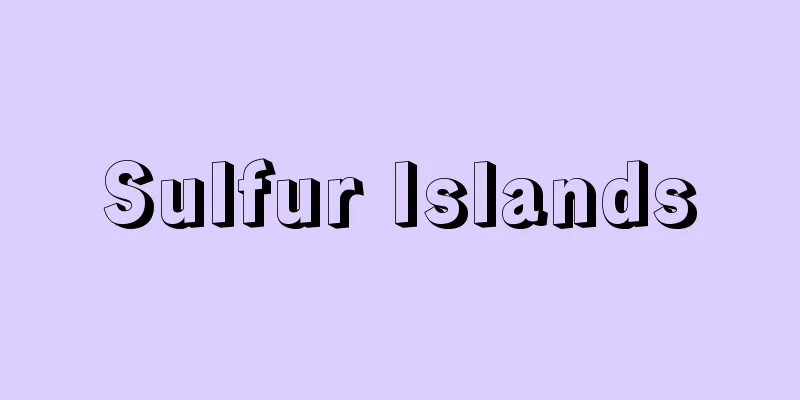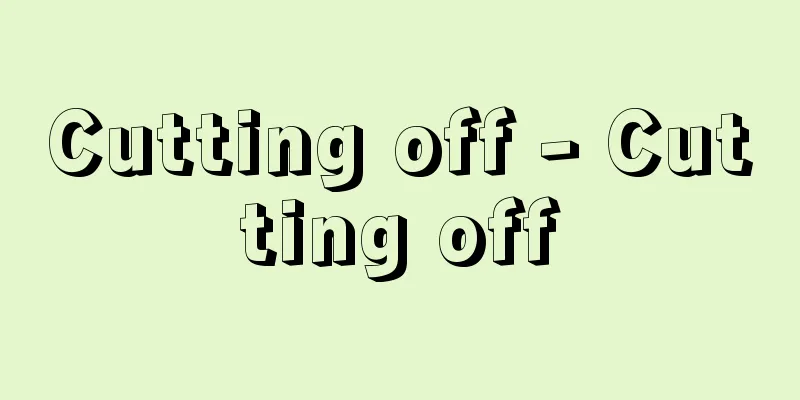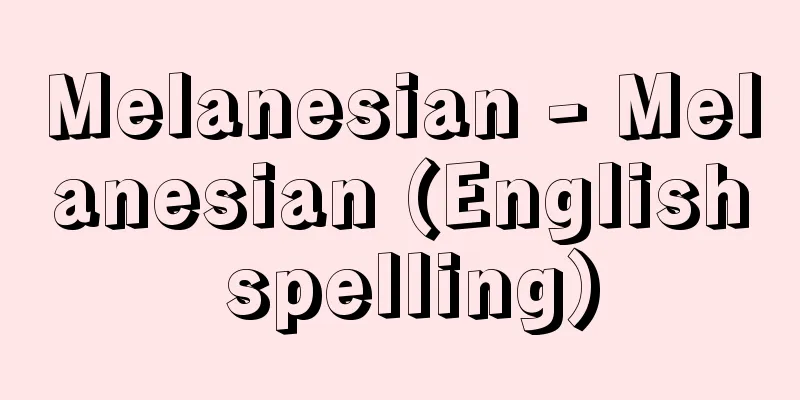Jamaica - Jamaica (English spelling)

|
Jamaica is a constitutional monarchy with the British King (Queen) as head of state, consisting of the third largest island in the West Indies in the Caribbean Sea, and many small uninhabited coral reef islands. Cuba is 145 km to the north, and Hispaniola is to the east. The country's name means "land of wood and water" in the language of the indigenous Taino people. It has an area of 10,991 square kilometers, roughly the same as Gifu prefecture in Japan, and has a population of 2.663 million (2006 estimate) and 2.74 million (2011 estimate). The capital is Kingston, with a population of 650,000 (2010 estimate). [Naoko Kurihara and Iyo Kunimoto] NatureJamaica is a long island, 240 km from east to west and 60 to 80 km from north to south. The Central Mountain Range runs through the central part of the island, slightly northward, and the Blue Mountains in the east are the highest peaks, with the famous Blue Mountains (2,256 meters), a coffee brand. Surrounding the mountain range, limestone plateaus, which make up 60% of the country's land area, spread from the central to western parts of the island, and karst topography is abundant in the Cockpit Country region in the northwest. Many rivers, including the Grande River, flow out of the Central Mountain Range, many of which become groundwater and run underground, before springing up at the foot of the mountains. Alluvial and coastal plains have developed in the south, and the widest part is west of the capital, Kingston. The climate is tropical and marine, but due to the many mountains, it varies by region. Rainfall exceeds 2,000 mm per year in the east, due to the influence of the topography and trade winds, and reaches 5,600 mm in the Blue Mountains, the highest in the West Indies. In the southern coastal plain, the amount of rainfall is about 1000 mm. The heaviest rainfall occurs from August to October, with the dry season occurring from November to April. The temperature ranges from 24 to 27°C throughout the year, except in the southeastern coastal areas, and is bearable due to the influence of the trade winds. Hurricanes strike every year from late summer to autumn, causing great damage, and as Jamaica itself is a volcanic island, earthquakes also occur. [Kunimoto Iyo] historyColumbus arrived here on his second voyage (1494). In 1509, the Spaniard Juan de Esquivel conquered the indigenous Taino people, beginning the long history of colonization. As no underground resources were discovered, agricultural development focused on food production, and the indigenous people were exploited as labor, causing a sharp decline in the population in a short period after the conquest. As a stopover point for trade ships connecting Spain with South America, it played a part in Spanish colonial trade, but its importance was not as great as that of Hispaniola. The British expedition dispatched under the "Western Plan" policy to seize Spanish territories in the Caribbean, devised by British Prime Minister Cromwell, failed to occupy Hispaniola, and then occupied Jamaica (1655). Spain formally ceded Jamaica to Britain in the Treaty of Madrid concluded in 1670. As a result, in the second half of the 17th century, Port Royal on Jamaica prospered as a base for British pirates targeting Spanish trading ships sailing in the Caribbean, but the city was destroyed by a major earthquake in 1692, and the capital was moved to Kingston. In the 18th century, Kingston became an important base for the British Navy. Sugarcane cultivation was introduced to Jamaica, and in the 18th century, it developed into one of the leading sugar producing areas in the West Indies, surpassing Barbados, which had prospered in the 17th century, and further became the largest sugar producing area in the British colonies in the early 19th century. A 1774 census of Jamaica reported 680 sugar plantations, covering one million square kilometres, with 105,000 slaves and 65,000 livestock. Another large estate was recorded to have 40,000 slaves working an area of 1,200 square kilometres. Jamaica was also the center of the triangular slave trade connecting Britain, Africa, and the Caribbean, and 400,000 slaves were introduced to the country by the time slavery was abolished in the mid-19th century. The abolition of slavery in the West Indies in the 1830s and the adoption of the free trade system by Britain in 1848 dealt a major economic blow to Jamaica. Furthermore, competition among the West Indies over sugar production, the start of sugarcane plantation cultivation in Java by the Netherlands, and the emergence of the sugar manufacturing industry using sugar beets in Eastern Europe led to a decline in the Jamaican economy. Jamaica's economy boomed again after the Second World War due to the development of bauxite. The path to independence was paved with the establishment of parliament through elections in 1944, the adoption of a parliamentary cabinet system in 1953, and the acquisition of complete self-government in 1959. The year before, in 1958, the Federation of the West Indies was formed with Jamaica, Trinidad, and other British colonies in the West Indies. Jamaica, which saw membership in the Federation as disadvantageous, withdrew in 1961, and became the first independent country among the British colonies in the West Indies on August 6, 1962. Since independence, the two major parties, the conservative Jamaica Labour Party (JLP) and the center-left People's National Party (PNP), have alternated in power. In the 1970s, the country experienced economic turmoil due to radical socialist policies under the PNP's Manley administration, but the JLP's Seaga administration, which was elected in 1980, made a major shift in political and economic policies to a pro-American and liberal course. The PNP regained power in the 1989 election, but the returning Manley government changed course from its previous socialist course and followed the economic policies of the previous government, winning a landslide victory in the 1993 election. Meanwhile, the JLP, which lost in this election, split up and formed a new party, and political reorganization proceeded. The PNP subsequently won landslide victories in the 1997 and 2000 elections, ruling for four consecutive terms, but lost public support in the 2007 general election due to delays in recovery from the hurricane disaster, and the opposition JLP won, realizing a change of government. However, the PNP regained power again in the 2011 election. This two-party system of government, which allows for a change of government, has not necessarily led to stability in the public safety situation. Since the 1980s, armed violent organizations have intensified their drug trade, and the government, at the strong urgency of the United States, has implemented a policy of strengthening its crackdown on drug organizations, leading to armed clashes between security forces and drug organizations in 2010, leaving more than 50 people dead. [Kunimoto Iyo] PoliticsIt is a member of the British Commonwealth of Nations and is a constitutional monarchy with the King (Queen) as head of state, and the Governor-General as the King's representative. The parliament is bicameral, with an Upper House consisting of 21 members, 13 of whom are recommended by the Prime Minister and 8 by the Opposition Leader, and a Lower House consisting of 63 members elected by popular suffrage. Both have a term of five years, and the Prime Minister is appointed by the Governor-General from the majority party leader in the Lower House. The two major political parties, the Jamaica Labour Party (JLP) and the People's National Party (PNP), which were formed in the wake of the rise of the labor movement in the 1930s, have overwhelming power, and have alternated in power since independence. In terms of foreign relations, Jamaica is primarily focused on cooperation with the United States and solidarity and cooperation with the Caribbean countries, and is a major driving force behind the Caribbean Community (CARICOM), but there was also a period when Jamaica was close to the Soviet Union, Eastern European countries, North Korea, and Cuba under the Manley administration, which declared "democratic socialism" in 1974. [Kunimoto Iyo] Economy and IndustryThe Jamaican economy is made up of four sectors: agriculture, mining, manufacturing, and tourism. Although the agricultural sector accounts for only around 6% of the gross domestic product (GDP) (as of 2009, the same applies below), it absorbs around 20% of the workforce, and around half of the country's land area is used for farming. Although its importance has declined, sugar production, a traditional export product since the colonial era, remains an important economic sector, accounting for around 10% of total exports. Traditional agricultural export products other than sugar include bananas, cocoa, and coffee. While these export-oriented agricultural products are an important pillar of the economy, Jamaica is also a food importing country, with around 10% of total imports being spent on food. Mining is centered on bauxite and alumina mining, which are the most important export products accounting for about half of total exports. Bauxite, discovered in 1942 and mining started in 1952, has been confirmed to have one of the world's largest reserves, and is the fourth largest producer in the world (2010). The manufacturing industry, which has seen remarkable growth in recent years, is centered on garments and sewn products, and has grown to account for around 15% of total exports. The tourism industry, which plays a major role in employment and foreign currency acquisition, has developed resort facilities mainly in Montego Bay and Ocho Rios on the northern coast of Jamaica, and the blue skies, bright sunshine, white sand beaches, and African culture and atmosphere attract Western tourists. Kingston is also the birthplace of reggae music, and many tourists visit the birthplace of Bob Marley, the founder of reggae music, which has been converted into a museum. The currency is the Jamaican dollar (JMD). [Kunimoto Iyo] Society and CultureJamaica claims to be a multi-ethnic and multicultural nation, and although 95% of the population is made up of African-Americans and mixed races, it is also a multi-ethnic and multicultural nation with a number of small but significant ethnic groups, including Europeans, Chinese, Indians, and Arabs. As a result of this racial and ethnic composition, there is a diversity of religions. Christianity, including the Church of England, Protestantism, and Catholicism, is the mainstream, but in addition to Islam and Hinduism, there is also a unique new religious movement, Rastafari, characterized by a desire to return to Africa. In particular, the Rastafari movement advocates black supremacy and the idea of returning to Africa, and has spread among residents of other Caribbean regions and African immigrants who have migrated to Europe and the United States. The official language, English, is a mixture of West African and other languages, with a strong Jamaican accent, but those with a high level of education speak British English. Compulsory education is from 6 to 12 years old, but public schools are free up to high school, and the literacy rate for those 15 years old and over is 90% (2010). Kingston is the headquarters of the University of the West Indies, a joint venture between the Commonwealth countries of the West Indies. [Kunimoto Iyo] Relations with JapanWhen Jamaica gained independence in 1962, Japan recognized the country's status and diplomatic relations were established the following year in 1963. Both countries have embassies in each other's countries. In terms of trade relations, Jamaica has a large trade deficit with Japan in the areas of automobiles and machinery, but Japan is the largest importer of Jamaican coffee, including the world-famous Blue Mountain Coffee. Jamaican music, such as reggae, is also widely known in Japan. [Kunimoto Iyo] From Columbus to Castro: A History of the Caribbean, 1492-1969, I and II, by Eric Williams, translated by Kawakita Minoru (2000, Iwanami Shoten) From the Mediterranean to the Caribbean, by Kamo Yuzo (1996, Heibonsha) Rastafarians: The Idea that Gave Birth to Reggae, by L.E. Barrett, translated by Yamada Hiroyasu (1996, Heibonsha) [References] | | [Additional Materials] |"> Jamaica flag ©Shogakukan Illustration/Shogakukan Creative "> Jamaica location map Source: Shogakukan Encyclopedia Nipponica About Encyclopedia Nipponica Information | Legend |
|
カリブ海域の西インド諸島で3番目に大きなジャマイカ島と多くの無人のサンゴ礁でできた小島からなる、イギリス国王(女王)を元首とする立憲君主国。北方145キロメートルにキューバ島が、東方にイスパニョーラ(エスパニョーラ)島が位置する。国名は先住民族タイノのことばで「木と水の大地」を意味する。日本の岐阜県の面積とほぼ同じ1万0991平方キロメートルで、人口266万3000(2006年推計)、274万(2011年推計)が住む。首都はキングストンで人口65万(2010年推計)。 [栗原尚子・国本伊代] 自然ジャマイカ島は、東西240キロメートル、南北60~80キロメートルの横長の島で、そのやや北寄りの中央部を中央山脈が連なり、東部のブルー・マウンテンズ山地には、コーヒーのブランド名として有名なブルー・マウンテン山(2256メートル)が最高峰としてそびえる。山脈を取り囲むように中央部から西部にかけては、国土の60%を占める石灰岩台地が広がり、北西部のコックピット・カントリー地方にはカルスト地形が多くみられる。グランデ川など多数の河川が中央山脈から流れ出て、その多くは地下水となって伏流し、山麓(さんろく)で湧出(ゆうしゅつ)する。南部には沖積平野と海岸平野が発達し、首都キングストンの西方でもっとも広くなっている。気候は熱帯海洋性であるが、山が多いために地域によって異なり、降水量は地形と貿易風の影響で、東部では年間2000ミリメートルを超え、ブルー・マウンテン山では西インド諸島中最高の5600ミリメートルに達する。南部の海岸平野では1000ミリメートル程度である。8~10月にもっとも降水量が多く、11~4月は乾期である。気温は南東部海岸地域を除いて年間24~27℃で、貿易風の影響でしのぎやすい。晩夏から秋に毎年ハリケーンが襲い、大きな被害を与えるほか、ジャマイカ島そのものが火山島であるため、地震も発生する。 [国本伊代] 歴史コロンブスが第二次航海時(1494)に、この地に到達。その後1509年にスペイン人フアン・デ・エスキベルが先住民タイノを征服して長い植民地時代の歴史が始まった。地下資源が発見されなかったため、食糧生産を中心とした農業開発が進み、先住民は労働力として酷使され、征服後短期間にその人口を激減させた。スペインと南アメリカを結ぶ貿易船の中継地としてスペインの植民地貿易の一翼を担ったが、その重要性はイスパニョーラ島には及ばなかった。 イギリスの宰相クロムウェルが立案したカリブ海のスペイン領の奪取政策「西方計画」によって派遣されたイギリス遠征隊がイスパニョーラ島の占領に失敗したのちジャマイカ島を占拠(1655)し、スペインは1670年に締結したマドリード条約で正式にジャマイカ島をイギリスに割譲した。その結果、17世紀後半のジャマイカ島ポート・ロイヤルはカリブ海を航行するスペインの交易船をねらうイギリスの海賊の拠点として繁栄したが、1692年の大地震によって街が壊滅し、首都がキングストンに移転された。18世紀にキングストンはイギリス海軍の重要な基地となった。ジャマイカにはサトウキビ栽培が導入され、18世紀には、17世紀に繁栄をきわめたバルバドスを抜いて西インド諸島有数の砂糖生産地へと発展し、さらに19世紀初めにはイギリス植民地最大の砂糖生産地となった。 1774年に実施されたジャマイカの統計調によると、680の砂糖プランテーションがあり、100万平方キロメートルの大農場では10万5000人の黒人奴隷と6万5000頭の家畜によりサトウキビが栽培されていたと報告されている。ほかの大農地でも、1200平方キロメートルに4万人の黒人奴隷が働いていたことが記録されている。 イギリス、アフリカ、カリブ海を結ぶ三角奴隷貿易の中心地でもあったジャマイカには、19世紀なかばの奴隷制廃止までに40万人の奴隷が導入された。1830年代の西インド諸島における奴隷廃止と1848年のイギリスの自由貿易制の採用は、ジャマイカに大きな経済的打撃を与えた。さらに砂糖生産をめぐる西インド諸島間の競争、オランダのジャワ島におけるサトウキビのプランテーション栽培の開始、東ヨーロッパにおけるサトウダイコンによる製糖業の登場により、ジャマイカの経済は衰退した。 ジャマイカの経済がふたたび活況を呈するのは、第二次世界大戦後のボーキサイトの開発によってである。1944年の選挙による議会設置、1953年の議院内閣制の採用、1959年の完全自治権の取得によって独立への道が準備された。その前年の1958年にジャマイカとトリニダードを中心に、そのほかの西インド諸島イギリス植民地を含めて西インド諸島連邦が結成されたが、同連邦の加盟を不利とみたジャマイカは1961年に脱退し、1962年8月6日に西インド諸島イギリス植民地のなかで最初の独立国となった。独立後、保守派のジャマイカ労働党(JLP)と中道左派の人民国家党(PNP)の二大政党が交互に政権を担当している。1970年代にPNPのマンリー政権下で急進的な社会主義政策による経済的混乱を経験したが、1980年の選挙で成立したJLPのシーガ政権は親米・自由主義路線へと政治・経済政策を大きく転換させた。1989年の選挙でPNPが政権を奪還したが、返り咲いたマンリー政権もかつての社会主義路線から方向転換して前政権の経済政策を踏襲し、1993年の選挙で圧勝した。一方この選挙で敗れたJLPは分裂して新党が結成されるなど、政界の再編成が進んだ。その後、1997年と2000年の選挙でも、PNPが圧勝し、4期連続して政権を担当したが、2007年の総選挙ではハリケーン災害の復旧の遅れなどで国民の支持を失い、野党のJLPが勝利して政権交代が実現した。しかし2011年の選挙ではふたたびPNPが政権を奪還した。このように政権交代を可能としている二大政党による政治運営も治安の安定とはかならずしもつながらず、1980年代から武装化した暴力組織が麻薬取引を活発化させ、アメリカの強い要請を受けた政府による麻薬組織の取り締まり強化政策に伴って、2010年には死者50名を超す、治安部隊と麻薬組織の武力衝突が発生した。 [国本伊代] 政治イギリス連邦の一員で、イギリス国王(女王)を元首とする立憲君主制をとり、国王の代理として総督が任命される。議会は二院制で、首相推薦の13名と野党指導者推薦の8名の計21名で構成される上院と、普通選挙により選出された63名からなる下院がある。任期はともに5年で、首相は下院における多数党党首が総督により任命される。政党は1930年代の労働運動の高揚に伴い組織されたジャマイカ労働党(JLP)と人民国家党(PNP)の二大政党が圧倒的な力をもち、独立後は交互に政権を担当している。対外関係では、対米協調とカリブ海諸国との連帯・協調が主軸で、カリブ共同体(CARICOM(カリコム))の主要な推進国となっているが、かつて1974年に「民主社会主義」宣言を行ったマンリー政権の下で当時のソ連、東欧諸国、北朝鮮、キューバへ接近した時期もあった。 [国本伊代] 経済・産業ジャマイカ経済は、農業、鉱業、製造業および観光業の4部門から成っている。農業部門は国内総生産(GDP)の6%前後(2009年、以下同じ)を占めるにすぎないが、労働人口の約20%を吸収しており、国土の約半分が農地として活用されている。植民地時代からの伝統的輸出産品である砂糖の生産は、その重要性が低下しているとはいえ、輸出総額の10%前後を占める重要な経済部門である。砂糖以外の伝統的な農業輸出産品には、バナナ、カカオ、コーヒーなどがある。このような輸出向けの農産物が経済の重要な柱になっている一方で、ジャマイカは輸入総額の10%前後を食糧に当てるほど食糧輸入国でもある。 鉱業はボーキサイト・アルミナ鉱業が中心で、輸出総額の約半分を占めるもっとも重要な輸出産品である。1942年に発見され、1952年に採掘が始められたボーキサイトは、世界有数の埋蔵量が確認されおり、生産量では世界第4位(2010)である。 近年成長が著しい製造業は衣料縫製品を中心として、輸出総額の15%前後を占めるまでに成長している。雇用および外貨獲得で大きな役割を果たしている観光業は、ジャマイカ島北部海岸のモンテゴ湾やオチョリオスを中心にリゾート施設が整備されており、青い空と輝く太陽に白い砂浜、アフリカ的な文化風土が欧米の観光客を引き付けている。またキングストンはレゲエ音楽の発祥の地でもあり、博物館となったレゲエ音楽の始祖ボブ・マーリィの生家を訪れる観光客も多い。通貨はジャマイカ・ドル(JMD)。 [国本伊代] 社会・文化多民族多文化国家を標榜(ひょうぼう)するジャマイカは、アフリカ系黒人とその混血が国民の95%を占めているとはいえ、ヨーロッパ系、中国系、インド系、アラブ系など少数ながら多数の民族集団を擁する多民族多文化国家である。このような人種・民族構成の結果、宗教も多様である。英国教会、プロテスタント、カトリックを含むキリスト教が主流であるが、イスラム教、ヒンドゥー教などのほかにアフリカへの帰還願望を特色とする独特の新宗教運動ラスタファリがある。とくにラスタファリ運動は黒人優位主義とアフリカ帰還思想を掲げ、ほかのカリブ海地域の住民や欧米に移住したアフリカ系移民の間にも広まっている。公用語の英語は、西アフリカやそのほかの言語が混じって、ジャマイカなまりの強い英語となっているが、教育水準の高い人々はイギリス英語を話す。義務教育は6~12歳であるが、公立学校は高校まで授業料が無料で、15歳以上の識字率は90%(2010)である。キングストンには、西インド諸島のイギリス連邦諸国で共同運営する西インド大学の本部が置かれている。 [国本伊代] 日本との関係1962年(昭和37)のジャマイカ独立時に日本は国家の成立を承認し、翌1963年に国交を樹立した。相互に大使館を設置している。貿易関係は、自動車や機械類を日本から輸入しているジャマイカ側の大幅な輸入超過となっているが、世界的に有名なブルー・マウンテン・コーヒーを代表とするジャマイカのコーヒーの最大の輸入国は日本である。またレゲエなどを通じてジャマイカの音楽が日本で広く知られている。 [国本伊代] 『エリック・ウィリアムズ著、川北稔訳『コロンブスからカストロまで――カリブ海域史,1492―1969』Ⅰ、Ⅱ(2000・岩波書店)』▽『加茂雄三著『地中海からカリブ海へ』(1996・平凡社)』▽『L・E・バレット著、山田裕康訳『ラスタファリアンズ――レゲエを生んだ思想』(1996・平凡社)』 [参照項目] | | [補完資料] |"> ジャマイカの国旗 ©Shogakukan 作図/小学館クリエイティブ"> ジャマイカ位置図 出典 小学館 日本大百科全書(ニッポニカ)日本大百科全書(ニッポニカ)について 情報 | 凡例 |
<<: Shamash - Shamash (English spelling)
>>: Soap Bubbles - Soap Bubbles
Recommend
Hakushu [town] - Hakushu
A former town in Kitakoma County in northwest Yama...
Oshi people - Oshi tribe
…Famous Sarmatian treasures include the artifacts...
Bahamas - Bahamas (English spelling)
A country consisting of the Bahamas Islands (excl...
Precipitation indicator
...The compounds shown in Table 3 emit different ...
Fishing gear - gyogu
A general term for equipment such as nets and fis...
《Jenufa》 - Ienufa
In 1881 he participated in the founding of the Br...
Cape Sata
Located at the southernmost tip of the Osumi Peni...
Brothers Grimm - Grimm Brothers (English spelling) Brüder Grimm
(Brother) Jacob Ludwig Carl 1785.1.4. Hanau - 1863...
Kondoúros, N. (English spelling) KondourosN
…Costa-Gavras, a Greek director who grew up in Fr...
cadmium
Cd. Atomic number 48. Electron configuration [Kr]...
Leshii
…The thunder god Perun occupied the highest posit...
Swanson - Gloria Swanson
American film actress. Born in Chicago. She start...
Constitutional review system
⇒Unconstitutional Legislation Review System Source...
Henry, Pierre
…He is the founder of musique concrète (concrete ...
Wind Flower
...His haiku are characterized by a relaxed sensi...









